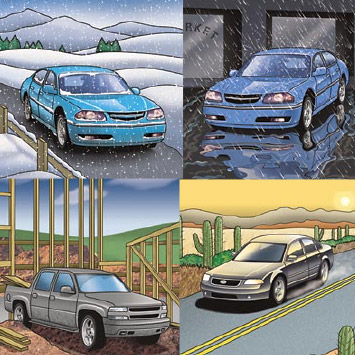Car Care Tips
What else can you do to protect your vehicle’s finish?
Regular washing should continue year-round, no matter the weather. But don’t stop there. Read on for additional tips on what to do. Then read about what to avoid:

Seasonal Advisories:
Winter
Windshield damage: Chips near windshield edges are harder to see, and more prone to spread as temperatures change. Repair small chips promptly, and improve your odds by keeping your distance from the vehicle ahead.
Snow and ice buildup: Scrapers can scratch paint, window tint and mirrors. Use them only for window exteriors.
Clamp-on ski racks can scratch and dent roofs if improperly installed.
Broken tire chains can damage fenders and wheel wells. Install per manufacturer instructions, drive at reduced speeds, don’t drive chained-up on dry roads, and remove broken chains immediately.
Christmas trees tied to roofs and trunks can scratch, scuff and dent. On reaching home, promptly remove ties, string or rope.
Spring
Hedges along driveways and roads will scratch vehicle finishes. Avoid them if possible, trim them back where you can.
Be careful using razor blades on old window stickers, and remember that commercial solvents can also damage paint. Use bug and tar removers specifically designed for automobiles.
Remove tree droppings as soon as possible. Globs of pitch on paint and glass won’t yield to normal washing, but should come off easily if manufacturer-recommended cleaning agents are used while the pitch is fresh. (Never use scouring pads or razor blades.)
Summer
Fresh tar and oil are everywhere. Avoid new paving if possible. If not, try to remove asphalt spatter while it’s fresh, using manufacturer-recommended cleaners. A detail shop may be needed to remove road striping paint, so try not to cross fresh-painted lines.
Spots on sun-heated vehicles are often caused by mineral deposits from drying water adhering to paint and glass. Avoid parking near sprinklers, and direct home sprinklers away from your car. Most spots can be rubbed out with paint-cleaning compound. Consult a detail shop, or we’ll show you how to do it yourself.
Fall
Leaves and pine needles can clog rain drains, causing water to back up and seep into your vehicle. Clean these drains regularly.
Bird droppings are acidic, and should be dealt with quickly, before paint damage occurs. Many birds ingest sand to aid digestion, making the droppings abrasive, so take care when removing them.
All Year Long:
Wash gas stains from around the fuel filler door as quickly as possible.
Remember: automotive trim is often affixed with plastic or metal clips that rust, and glue or tape that loses adhesiveness over time.
You’re likely to notice damage to the driver’s side as soon as you get in or out; but check the passenger side now and then as well.
“Park defensively”. Don’t park at the unprotected end of a row, and seek spaces next to new and/or well–kept vehicles.
Center your car between the lines, to give folks next to you room to open their doors without banging yours.
If kids are playing ball nearby, seek street parking elsewhere, or risk returning to find dimples, marks or dents.
Merely brushing against a dirty car can mark the finish, so never lean against your car, rest grocery bags on hood or roof, or jostle keys against the metal while unlocking doors or trunk.